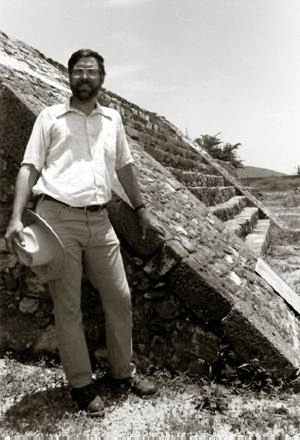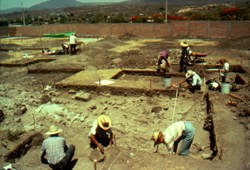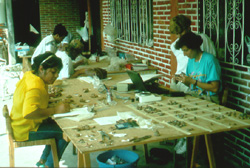| As a budding anthropologist
in Mexico, Michael Smith wasn't lured by the glitz of Mayan monuments or
the opulence of the Aztec Empire's temple pyramids.
Emperors and kings and their glittering
trappings of buried royalty left Smith bored. Plenty of other Meso-American
scholars had been there, done that.
 Instead, since 1974, beginning as an undergraduate student at Brandeis
University, Smith has focused on a ground-level view of Aztec civilization.
Instead, since 1974, beginning as an undergraduate student at Brandeis
University, Smith has focused on a ground-level view of Aztec civilization.
By leaving the well-worn path of monumental
archaeology and its obsession for royal tombs, he has discovered undisturbed
riches of knowledge through archaeological digs and artifact analyses probing
the mundane details of the lives of Aztec commoners.
"It's a little discouraging that the royal
tombs still get all the press," Smith said, holding up a recent National
Geographic article on a Maya tomb. "I've always worked from the perspective
that we learn more about the Aztecs digging the
houses of peasants."
Smith found the key to unlocking this secret
life of the Aztecs was in the garbage heaps a stone's throw out the back
door of each house. The garbage heaps and adjacent houses of the peasants
also happened to be among the few structures the Spanish conquistadors
did not destroy when they vanquished the Aztec Empire.
Smith, professor of anthropology at the University
at Albany and director of its Institute for Mesoamerican Studies, is perhaps
the world's leading authority on the daily life of 15th-century Aztec peasants
who occupied an area now part of the present-day Mexican state of Morelos
in the highland valleys near Mexico City.
With the help of Albany undergraduate and
graduate students digging sites in the
ancient Aztec provinces of
Yautepec
and Cuexcomate (near today's city of Cuernavaca) over the course of
dozens of field visits, Smith has assembled a remarkably
detailed portrait of daily provincial life.
He has discovered the texture of the Aztec
commoners' existence more than 500 years ago: what they ate, how they farmed,
what they made to trade for goods at market, what their dwellings were
like, how they fit into the Aztec Empire's hierarchy.
"This might not be as exotic as human  sacrifices
and the large temples, but it fills in the gaps of our knowledge," said
Smith, who joined Albany's faculty in 1991. sacrifices
and the large temples, but it fills in the gaps of our knowledge," said
Smith, who joined Albany's faculty in 1991.
After two decades of toiling mostly beneath
the academic radar screen, his bottom-up approach to studying ordinary
Aztecs has gained recent attention and support. Smith published a major
article, "Life in the Provinces of the Aztec Empire," in the September
1997 issue of Scientific American. His book, The Aztecs (Blackwell, $25.95),
was published last year, and a History Book Club reviewer praised its "new
comprehensive view of the Aztecs and their civilization." The paperback
version came out this year and is one of Blackwell's best sellers.
Smith is currently analyzing artifacts from recent excavations at Yautepec
with the help of a $150,000 grant from the National Science Foundation.
He has received funding in the past from the National Endowment for the
Humanities, National Geographic Society and private foundations.
Smith, of Clifton Park, has managed to balance
home with work. His Mexico excavations have become a family affair. His
wife, Cynthia Heath-Smith, is an accomplished anthropologist and helps
him on dig sites and in research and writing. Their children, April, 17,
and Heather, 14, spent summers in Mexico growing up. They attended school
in Mexican villages, befriended local children and became fluent in Spanish.
"My family has come to love Mexico, its people,
the food, the music, the history," Smith said. "After our first visit,
we were hooked."
In Mexico, they have become close friends
of the Ramirez family, who live in Tetlama, a farming village of about
1,000 people. Pedro Ramirez and his wife, Elizabeth, have worked at the
dig sites, as has Pedro's uncle, father, brothers and other relatives.
The Smiths are godparents to the Ramirez children, Gustavo and Fermin,
pictures of whom adorn Smith's campus office, along with photographs, maps
and handcrafted goods from Mexico.
At the end of each summer dig season, villagers throw a fiesta for
Smith and his students. They grind corn for tortillas and cook them by
hand over a tortilla griddle heated by rocks fired in a  hearth.
The villagers invite the gringos into their small adobe houses. It is as
if the clock were turned back 500 years to the time of the Aztecs. hearth.
The villagers invite the gringos into their small adobe houses. It is as
if the clock were turned back 500 years to the time of the Aztecs.
As it turns out, Smith has determined that the daily life of Aztec
commoners was not radically different from village life in Morelos today.
Dinner 500 years ago was typically beans and
corn tortillas. Aztec peasants lived in simple dwellings on the periphery
of town, which was dominated by a compound for a noble family, a public
market plaza and temple pyramid. A typical peasant house was small, measuring
about 45 to 75 square feet, and probably had two doors and no windows.
The house was built with a cobblestone foundation, adobe brick walls and
thatch roof.
Aztec peasants were more prosperous,
more enterprising and more engaged in a market economy than previously
thought, Smith found.
The biggest cottage industry was textile goods. Cotton was a major
crop in the area, and it was spun by hand using a wooden spindle, bead-like
spindle whorls as weights and small ceramic bowls with tripod supports
designed to control the spindle. Every excavated house had large quantities
of these spinning materials.
 The spun cotton was woven into textile goods using back strap looms. Woven
rugs, blankets and other items were traded in market plazas for salt, painted
pottery, obsidian blades, bronze needles and other imported products. The
commoners also traded woven mats, baskets, corn-grinding tools and tortilla
griddles.
The spun cotton was woven into textile goods using back strap looms. Woven
rugs, blankets and other items were traded in market plazas for salt, painted
pottery, obsidian blades, bronze needles and other imported products. The
commoners also traded woven mats, baskets, corn-grinding tools and tortilla
griddles.
Farming was difficult and the Aztecs
struggled to grow enough food to feed a rapidly increasing population.
They devised a masterful system of planting otherwise unusable ravines
with "check dams." Farmers piled up stones, one row at a time, which trapped
soil erosion during the rainy season. Terraces of rich sediment formed
behind the walls of stones as soil washed down the hillside after heavy
rains was trapped. These flat terraces on steeply sloped hillsides were
planted with maize, beans and cotton.
When Hernando Cortes and his conquering Spaniards
arrived in 1519, they quashed the Aztec practice of human sacrifice, but
not before the peasants had discovered unique uses for bones. An excavated
human thigh bone, for instance, had been scored with deep grooves to form
a kind of musical instrument.
Not only have Smith's excavations yielded
countless such details of the lives of 15th-century Aztec commoners, but
the sites have also served as superb training grounds for Albany students,
who have used their field work and research in Mexico to develop doctoral
dissertations; master's theses, and undergraduate honors theses.
The dig sites are filled back in after Smith's
team has photographed and catalogued the artifacts, which cannot leave
Mexico. Thousands of artifacts await analysis in the field. The cash-strapped
Mexican government cannot provide adequate artifact storage.
"Trying to preserve these artifacts is a big
issue," said Smith, who is applying for grants with two other American
anthropologists in the hopes of building a warehouse. "Without funding,
I'm not sure what will happen to this collection of artifacts."
In the meantime, however, Smith continues to piece together details
of Aztec life, and in best 20th-century fashion, he makes his findings
easily accessible on the University's Website at
www.public.asu.edu/~mesmith9.
University at Albany Home Page
Albany Magazine Home Page
|

